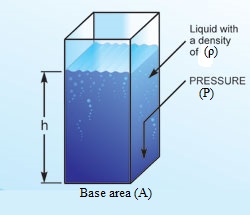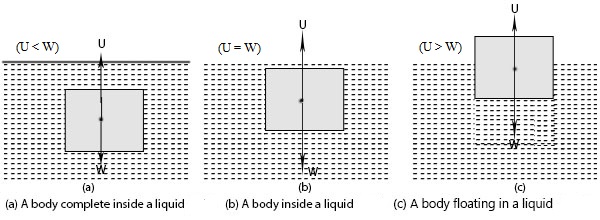
- The pressure given by a force is directly proportional to its magnitude, i.e.
Pressure (P) α Force (F) ………………………… (i)
- Similarly, the pressure given by a force is inversely proportional to the area where it acts, i.e.
Pressure (P) α 1/Area (A) ………………………… (ii)
- Combining equation (i) and (ii), we get,
P α (F/A)
Or, P= k (F/A) where, k is a constant
- The force is measured in Newton and the area is measured in square meter.
- Thus, pressure on the surface can be defined as the force (weight) acting perpendicularly on the unit area of that surface.
- The SI unit of pressure is Newton/metre2 which is also called Pascal (Pa) to honour the French scientist Blaise Pascal.
- If the force of one Newton acts on one square meter area, the pressure acting on it is 1
Practical applications of pressure:
- The base of the dams is made wide to reduce the pressure exerted by the dam structure and also to withstand the enormous pressure of the stored water.
- The base of walls of buildings, bridges and temples is made wider to reduce the pressure exerted by them.
- The tyres of buses and trucks have broad and double wheels so that the pressure on the tyres is reduced.
Pressure at a depth in a liquid due to liquid column only:
Consider a container with a base area ‘A’ which is filled to a depth ‘h’ with a liquid of density ‘ρ’.
The pressure acting on the base of the container is equal to the weight if the liquid pressing down on the base.
Here,
Volume of liquid = base area (A) x depth (h) = Ah
Mass liquid = density (ρ) x volume = ρ x Ah
Weight of liquid = mass of liquid (ρAh) x acceleration due to gravity (g)
Force at the base (F) = ρAhg
This force is acting on an area A,
Therefore,
The force exerted per unit area .i.e. pressure (P) = force (F) /area(A) = ρAhg/A=ρgh
i.e. P= ρgh

Factors affecting the pressure at a point in a liquid:
- Depth of the point below the free surface (h)
- Density of the liquid (ρ)
- Acceleration due to gravity (g)
Pascal’s law: Transmission of pressure in liquids
- Pascal’s law states that the pressure exerted at any point in a liquid enclosed in a container is transmitted equally in all directions throughout the liquid. The transmitted pressure, acts with equal force, on every unit area of the containing vessel in a direction at right angles to the surface of the vessel exposed to the liquid.

i.e. P1 =P2 or F1/A1 = F2/A2
or, F2 = F1(A2/A1) (frictionless and no leakage of water)
- Hydraulic press, hydraulic brake and car lifts work on the mechanism of Pascal’s law.
Liquid and its upthrust:
- The upward force exerted by a liquid on an object immersed in that liquid is called upthrust or buoyant force. In other words, upthrust is the resultant force with which a liquid pushes up an object when immersed into it.
- Upthrust (U) = weight of the object in air (W1)- weight of the object in liquid(W2)
i.e. U = W1 –W2
- U = A(h2-h1)ρg = Vρg = weight of liquid displaced = loss in weight of the body , where, V is the volume of liquid displaced.
Factors affecting the upthrust:
- The volume of the body immersed in liquid
- The density of liquid in which the object is immersed
Archimedes’ principle:
- Archimedes’ principle states that when a body is immersed partially or completely in a liquid, it experiences an apparent loss in weight due to upthrust, which is equal to the weight of fluid displaced by it.
When a body is immersed in a liquid, the following two forces act on it.
- The weight of the body which acts vertically downwards that tries to sink the body.
- The upthrust of the liquid acting vertically upwards that is equal to the weight of the liquid displaced.

Three possibilities that exist when an object is immersed in a liquid;
- The weight of the body is greater than the upthrust. The downward force is greater because of which the body sinks in the liquid.
- The weight of the body is equal to the upthrust. The upward and downward forces are equal because of which the body floats inside the liquid and the apparent weight of such body will be zero.
- The weight of the body is less than the upthrust. The upward force is greater which causes the body to rise up and float on the surface of the liquid. The density of such object is less than the density of the liquid.
Law of flotation:
The law of floatation states that when a body floats on a liquid, the weight of the floating body is equal to the weight of the liquid displaced.
Applications of the principle of flotation:
- Ships are hollow and full of air, which makes their average density less than that of water. The weight of the water displaced becomes equal to the total weight of the ship and hence the ship floats.
- Flotation of icebergs. This is because, the density of ice is less than that of water.